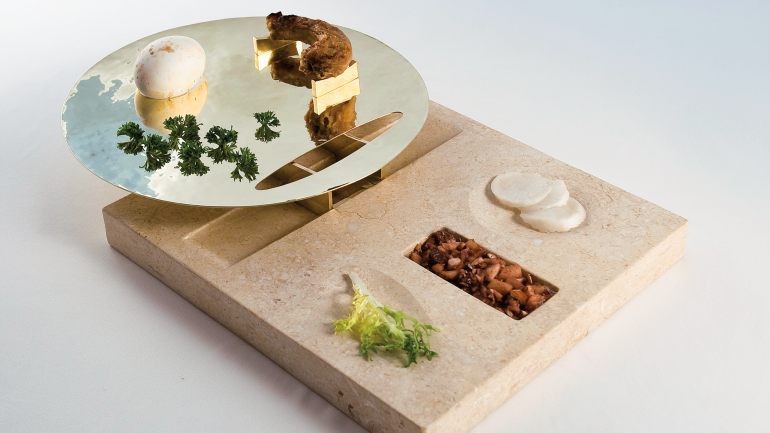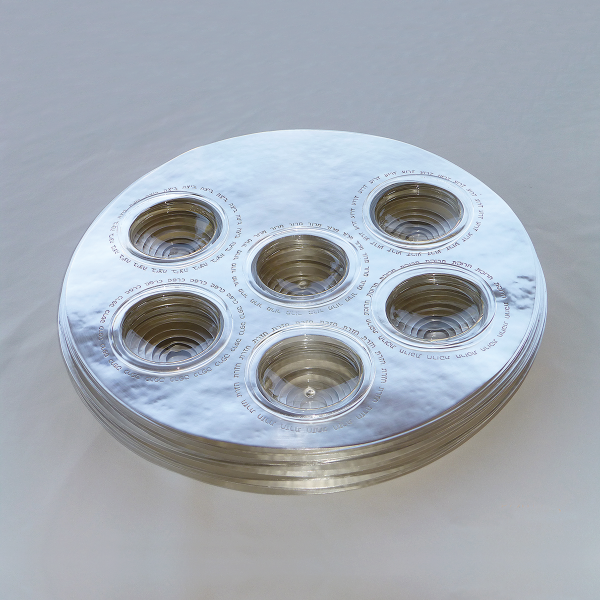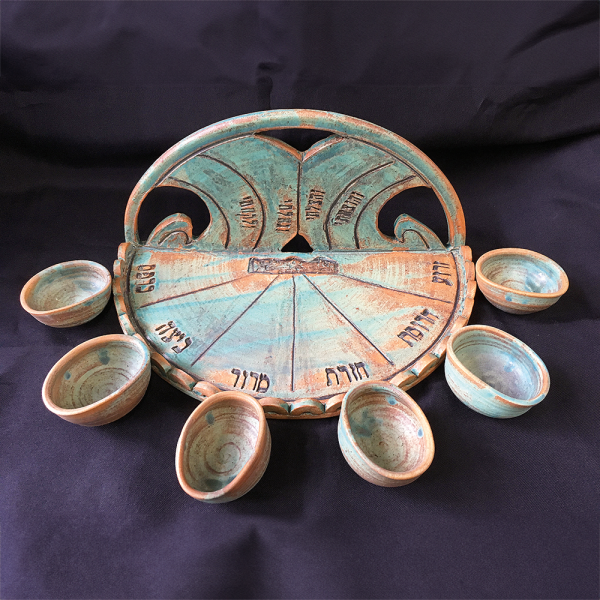Telling the Story
Telling the Story
Passover is an eight-day Jewish celebration of the Israelites’ escape from slavery in Egypt during the 13th century BCE. Its centerpiece is a meal called the seder, which usually takes place on the first night. Participants gather then to tell the story as outlined in the Haggadah, an ancient Jewish text.
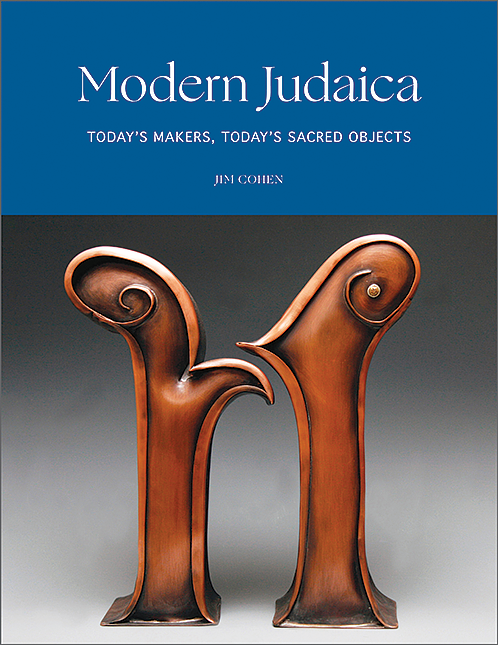
When I was a boy, our family Passover tradition involved a trek from Dayton, Ohio (and later Arlington, Virginia), to my grandparents’ home in Youngstown, Ohio, where my parents and I would join my father’s siblings and their families for the seder. The kids, who only got to see each other once a year, would run around and entertain themselves with games. The men would complain about the Cleveland Indians while playing pinochle. And as the festivities unfolded, my Zede (grandfather) and Bubba (grandmother) would rule their respective turfs with an iron hand.
The seder itself started at sundown and seemingly lasted forever. It was all in Hebrew and involved a reading of the Exodus story, as well as commentaries from ancient sages, and a tradition during which the youngest person present asks The Four Questions, a rhetorical device to prompt a discussion about what made this night different from any other.
The seder plate is at the center of the evening from beginning to end. It holds five or six traditional foods (there is disagreement on the number), all of which play a part in the storytelling. Three of the foods symbolize the Jews’ slavery: maror, a bitter herb, often horseradish; charoset, a paste made out of fruits, nuts, and wine representing the mortar Jews used for the Pharaoh’s construction projects; and chazeret, a second bitter herb. Three others are emblems of their freedom: beitzah, a roasted egg; karpas, a vegetable, usually parsley, eaten after being dipped in salt water; and pesach, a lamb shank. After hearing the story and the roles these foods play, we would (finally!) get to feast on a host of delicious delicacies, including homemade gefilte fish, brisket, chicken, macaroons, and whatever else Bubba and her daughters and daughters-in-law prepared.
These trips were a constant until Zede’s death in1962, when I was 12 and my parents adopted a new tradition. We stayed home and had seder with the Sprechers, the first family we met after moving to Virginia. Over the next 60 years, some 40 relatives and friends—whom I’ve long since come to think of as my “family”—have come from around the United States, Israel, and the Netherlands to mark Passover at the Sprechers’ home; it’s a tradition that’s lasted through the deaths of my parents and the elder Sprechers, countless marriages, and the birth of beloved children, grandchildren, and great-grandchildren.
Before I became a metalsmith, I didn’t pay much attention to what the seder plates looked like. In my memory they were simply round, silver or ceramic, and big. As I’ve reviewed my memories of seders past, though, I’ve come to appreciate that what ties my family’s ongoing practices together—making them traditions as opposed to one-off dinners—is not only the emphasis on family (biological and beyond), the Exodus story, and the customary foods, but the seder plate itself. I’ve also become convinced that the best way to examine almost any tradition is to understand the rituals and ritualistic objects that give it shape.
Making Judaica
I came to metalsmithing as a second career, following more than 20 years in the US Air Force and another five years as a Pentagon-based attorney. It was during those last five years that I began taking night classes at the Torpedo Factory Art Center in Alexandria, Virginia, and the Thomas Jefferson Community and Fitness Center in nearby Arlington. With a fool’s confidence, I resigned from my Pentagon job and went to the University of Wisconsin–Madison to get an MFA. Not long after graduation, I began specializing in Judaica—the ritual objects of Judaism—and attempted to adhere to three factors: whimsy, aesthetics, and function. I wanted to challenge preconceived notions of what a kiddush cup or a seder plate should look like, evoke “oohs” and “aahs” from viewers, and ensure the objects function as they’re meant to (for me, a founding principle of craft).
During this 25-year journey, I’ve repeatedly been vexed by the interface between Judaica and Jewish art. At one time, I actually tried expressing the relationship through a Venn diagram. While that appealed to my sense of empiricism, I realized it was, at best, not a very good representation. While writing and assembling Modern Judaica: Today’s Makers, Today’s Sacred Objects (Schiffer Publishing, 2022), I decided to look at that issue through the lens of what Judaica and Jewish art contribute to being Jewish. This led to the book’s slogan or catchphrase: “Jewish art tells the story; Judaica lives the story.”
There is a concept in contemporary Jewish thought called hiddur mitzvah, which can be roughly translated as “beautify the good deed.” This idea has engendered a wide-ranging expansion of Judaica as an expressive art form. In part, that’s because, while a biblical prohibition against the portrayal of God remains, hiddur mitzvah permits the Judaica maker to create “beauty” in works that facilitate the practice of Judaism and its rituals.
So, as an example of contemporary Judaica, the seder plate has no boundaries except those broadly established by the Haggadah. Do its various makers employ unusual materials or unfamiliar aesthetics? It really doesn’t matter. Those choices show the flexibility and freedom found in ritual life.
The concept of hiddur mitzvah also allows makers the luxury of creating seder plates that fit with the portions of the ritual they want to emphasize—as you’ll see in the plates below (all of them, except the oldest known seder plate, are also featured here). In other words, rather than form following function, function may follow form.
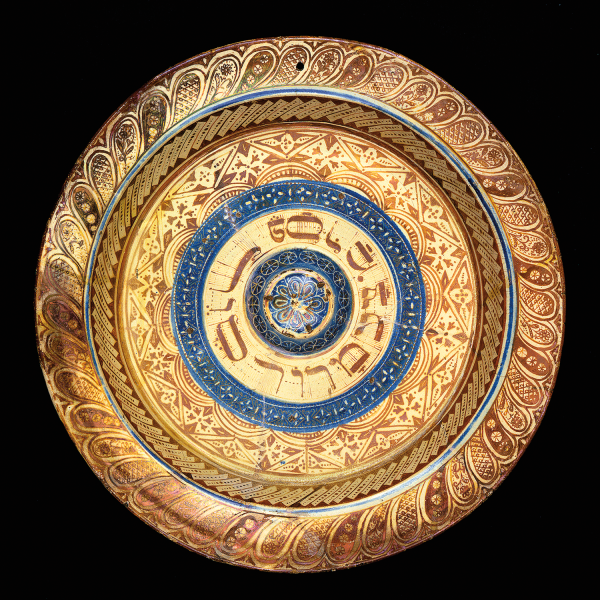
Photo © Israel Museum, Jerusalem, by Nahum Slapak.
This is the oldest known seder plate. From pre-expulsion Spain, it’s housed in the Israel Museum, Jerusalem. A ceramic lusterware plate created in the 15th century, it’s one of a very few ceremonial pieces known to have survived the expulsion of Jews from Spain in 1492. Like many of the contemporary pieces featured on these pages, there are references to elements of the seder written on the plate. In this case there are four: pesach, matzah, maror, and the word seder itself. Interestingly, there are slight errors in the Hebrew on the plate. This likely reflects the fact that, for hundreds of years, restrictions kept Jews out of the metalworking guilds—so many traditional objects were made by Christian craftspeople unfamiliar with Hebrew.
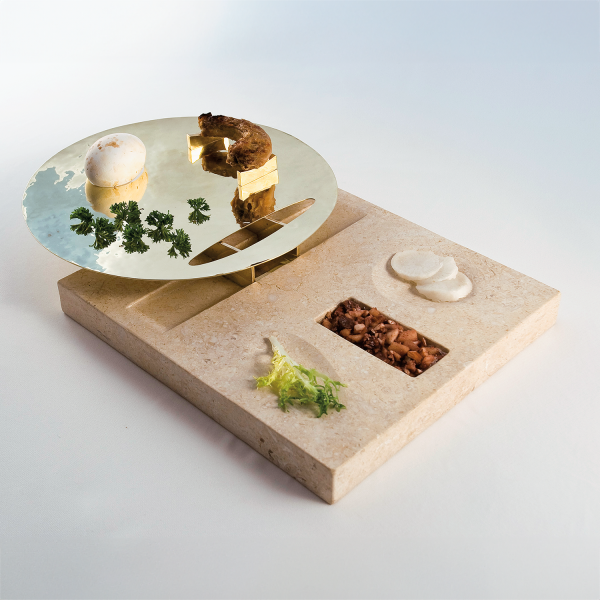
Photo by Amy Reichert.
Chicago architect and Judaica designer Amy Reichert’s stone and brass Seder Plate (2008) tells the Exodus story by focusing on bondage and liberation. The foods of slavery—maror, chazeret, and charoset—are found on the stone base, representing Jerusalem. The polished brass disc is for the foods of freedom: pesach, beitzah, and karpas. A channel exists between the levels for the salt water that moistens the karpas, representing the Red Sea. One of Reichert’s goals was to allow everyone access to the holiday, so there is no Hebrew on the plate.
amyreichertjudaica.com
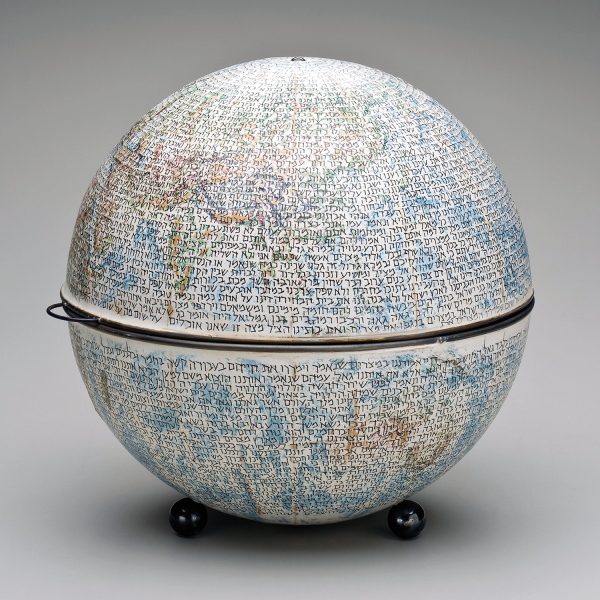
Photos by R. H. Hensleigh.
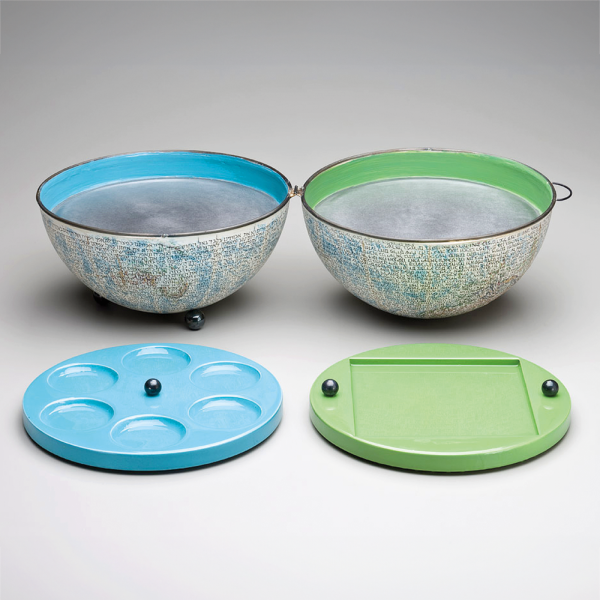
For all of its nuanced differences from home to home, Passover, perhaps more than any other Jewish holiday, adheres to a kind of baseline in its celebration. Berkley, Michigan–based Lynne Avadenka’s World Book (2009) brings the idea of this universality to the fore. Featuring a hand-lettered Haggadah, the cardboard globe opens in the center to display a seder plate and a tray for matzah, the unleavened bread that’s another important element in the Passover observance. This piece was done for a show at the San Francisco Contemporary Jewish Museum.
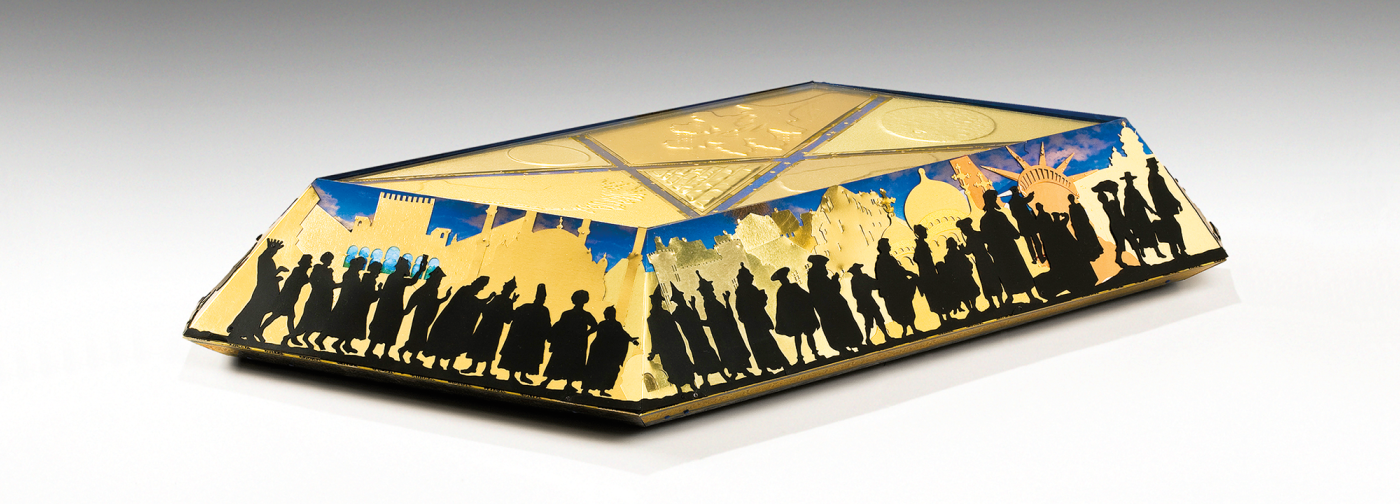
Photo by Phillip Cohen.
In creating Eons of Exodus (2008), classically trained silversmith Harriete Estel Berman of San Mateo, California, incorporated silhouettes from a 1923 Hebrew Union Haggadah. She coupled this with architectural images from the then newly renovated Contemporary Jewish Museum in San Francisco. The figures, with their various headwear and backgrounds, combine to address the universal significance of the Exodus for Jews throughout generations. The background pictures—of places important in Jewish history, including Ellis Island, Ottoman Turkey, and the Pyramids—make the message of exile even more effective. One panel represents the forced migration of women and children from Sudan; like the Jews leaving Egypt, they carry bundles on their heads. The material list for this piece is a classic example of Berman’s eclecticism: recycled tin cans, steel from toy appliances, 10k gold, and sterling silver and aluminum rivets.
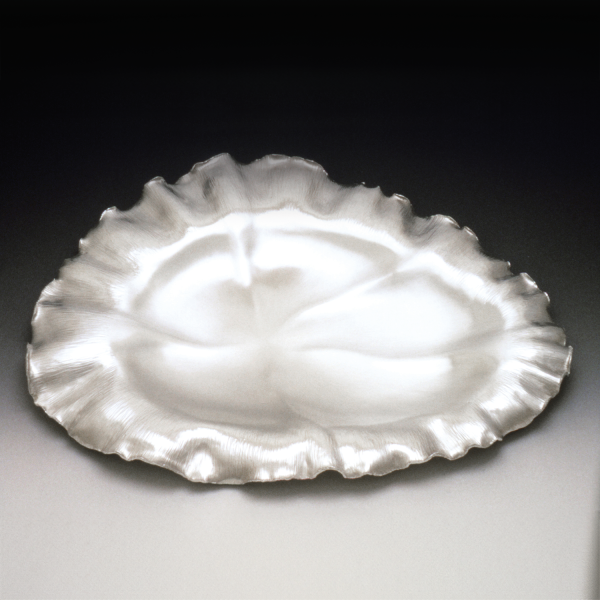
Photo by Cynthia Eid.
A great example of hiddur mitzvah (“beautify the good deed”), the principle that allows for great creativity in Judaica, is Veins II (1996) by Cynthia Eid, who lives near Boston. This piece was produced for the seder plate competition sponsored by the Spertus Institute in Chicago. As Eid researched the plates, she realized that most of them had six divisions, but the one she used at home had only five. After consulting with her rabbi, she kept her family tradition intact, creating this seder plate from a single sheet of sterling silver. There is no lettering, which reflects Eid’s belief in texture as a substitute for the visual interest that the Hebrew letters provide on other plates.
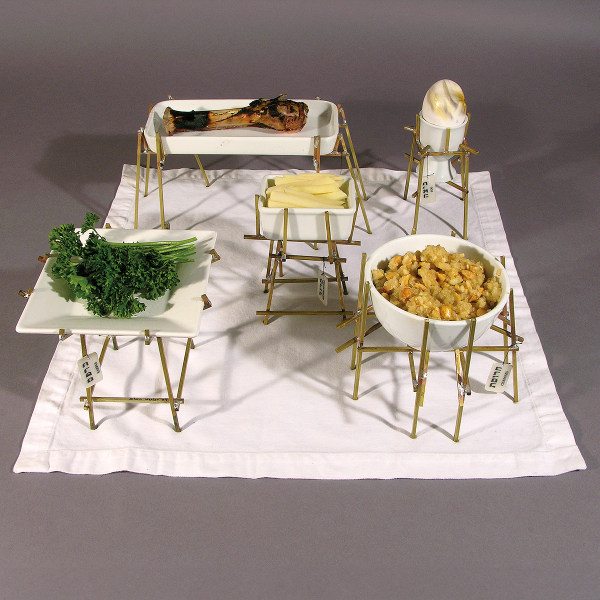
Photo by Allan Wexler.
For Allan Wexler, who lives in New York, Judaica is not about the past, it’s about the now. Trained as an architect, he has a contemporary sensibility, but he recognizes that the seder plate provides a conduit from one generation to another and that he has to deal with boundaries established by religious rules and a shared sense of history. Within these broad guidelines, he has found that there are unlimited possibilities. His deconstructed Scaffold Seder Plate (2009)—made of brass, ceramic, and cotton cloth—has only five “plates” for the foods: clockwise, pesach, beitzah, charoset, karpas, and, in the center, maror.


